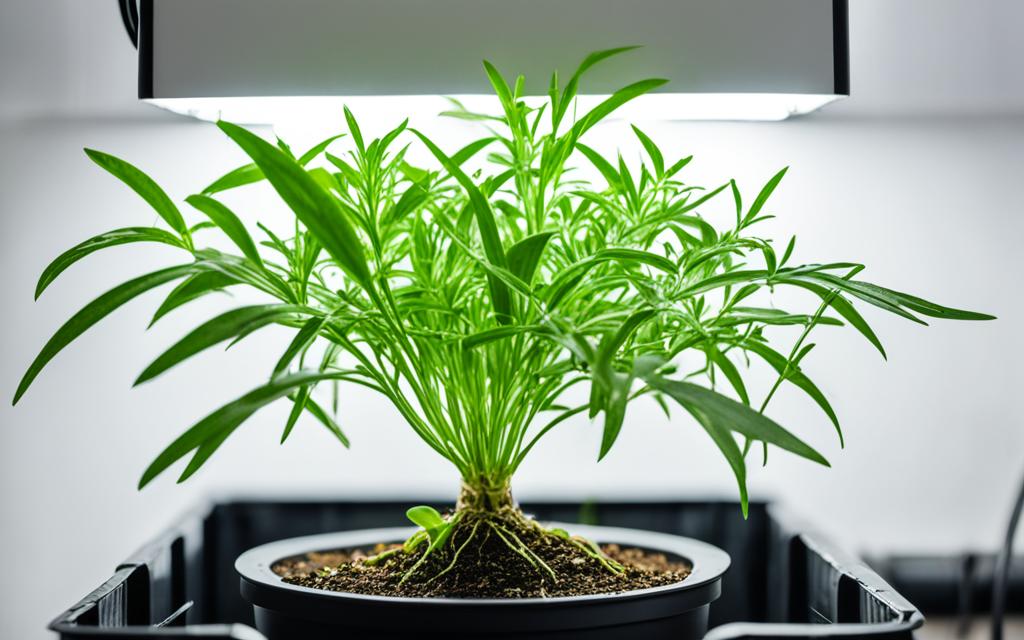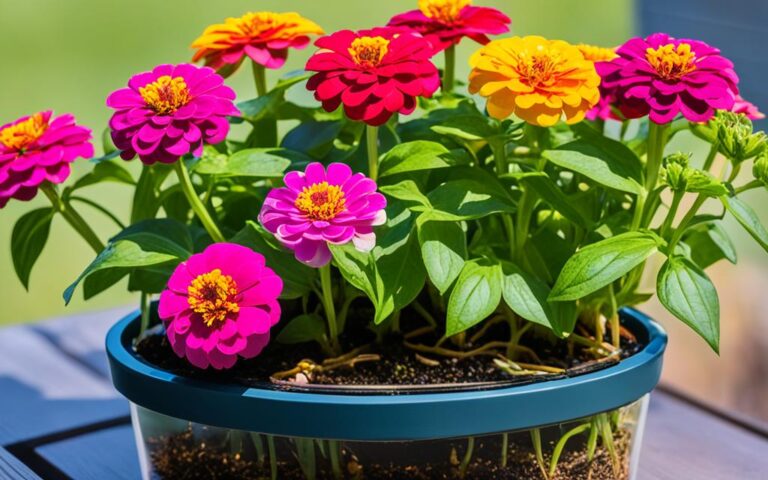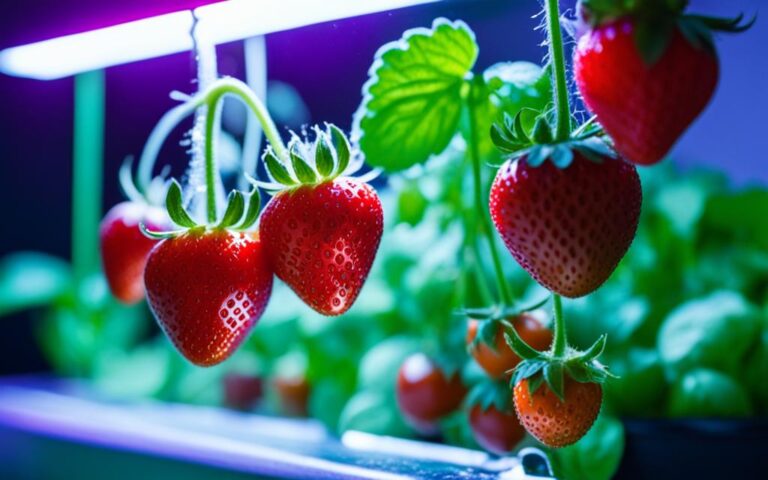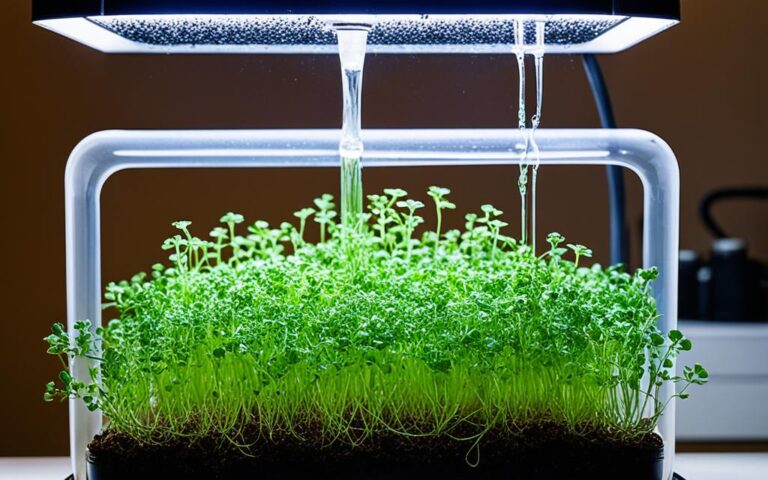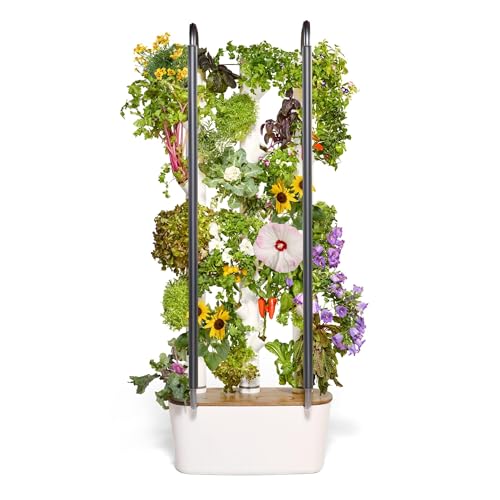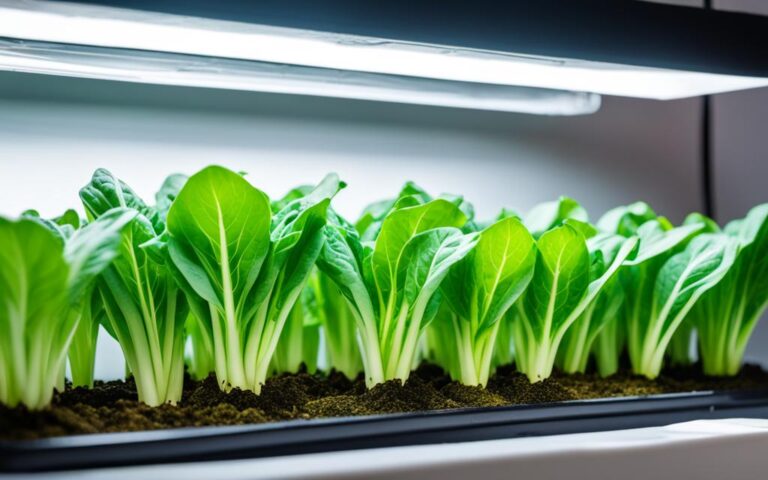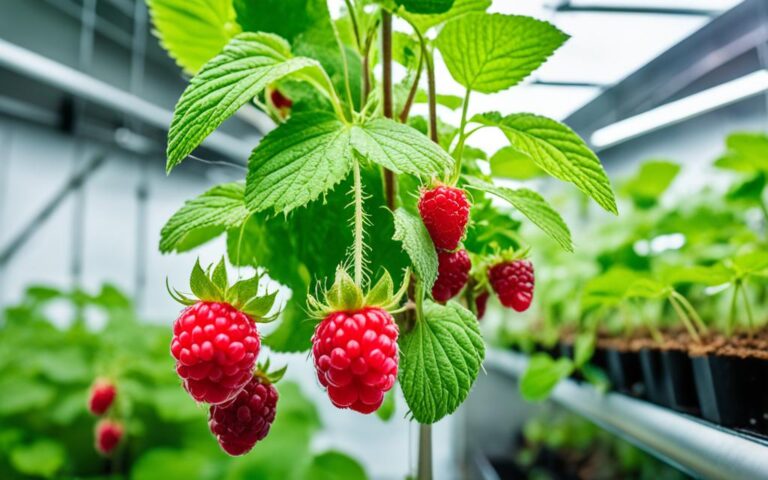Growing Hydroponic Tarragon: Tips and Techniques
Finding fresh tarragon can be tough at local stores. But, growing hydroponic tarragon lets you have it all year. This guide will show you how to grow tasty hydroponic tarragon. You’ll learn about the best hydroponic system setup, how to get lots of it, and how to keep it top quality.
Key Takeaways
- Hydroponic tarragon can be grown indoors year-round, providing a reliable source of this aromatic herb.
- Hydroponic systems allow for precise control over the growing environment, leading to optimal plant health and yield.
- Tarragon requires specific nutrient and environmental conditions, such as a pH range of 6.0-6.5 and 14-16 hours of daily light.
- Proper propagation, pruning, and harvesting techniques are essential for maintaining a thriving hydroponic tarragon crop.
- Careful pest and disease management is crucial for producing high-quality, organic herbs in a soilless cultivation setup.
Table of Contents
Introduction to Hydroponic Tarragon
Tarragon is a key herb known for its mild licorice taste. It’s a big part of French cooking. The French type (Artemisia dracunculus var. sativa) is best for cooking. Growing hydroponic French tarragon has many benefits over traditional farming. It’s great for both home and commercial growers.
Benefits of Growing Tarragon Hydroponically
There are many advantages to tarragon hydroponics:
- It lets you grow tarragon all year, giving you fresh herbs anytime
- It produces more herbs than soil farming, since plants grow faster
- It ensures herbs taste better and are of consistent quality, thanks to the right nutrients
- It lowers the chance of pests and diseases, since it’s grown in a clean space
- It saves space, as you can stack or set up systems in small areas
Varieties of Tarragon for Hydroponic Cultivation
The French tarragon (Artemisia dracunculus var. sativa) is best for hydroponic cultivation. It tastes richer and more complex than the Russian type. This makes it perfect for cooking.
Other tarragon types like hydroponic Mexican tarragon (Tagetes lucida) and wild tarragon (Artemisia dracunculus var. dracunculus) are also options. But the French tarragon is still top choice for growing tarragon hydroponically. It’s known for its great taste and versatility in cooking.
Setting Up a Hydroponic System for Tarragon
Growing tarragon in a hydroponic system is key to success. This herb loves well-aerated, nutrient-rich environments. Certain systems are perfect for it.
Choosing the Right Hydroponic System
The DWC and NFT systems are top choices for tarragon. They give tarragon the right conditions to grow. The roots get plenty of oxygen and nutrients.
Essential Components for a Tarragon Hydroponic Setup
For a great hydroponic tarragon setup, you need:
- A grow tray or container to house the plants
- A suitable grow media, such as rockwool or clay pebbles, to support the plant roots
- A nutrient solution delivery system, like a pump and tubing, to circulate the nutrient-rich water
- Appropriate lighting, such as LED grow lights, to provide the necessary light spectrum for optimal growth
Picking the right hydroponic system and having all the parts is crucial. This ensures your tarragon thrives. You’ll get a big, quality harvest.
The best temperature for tarragon is 70°F (21°C). It needs 14-16 hours of LED light daily. The ideal pH is 6.0-6.5, and EC levels should be 1.0-1.8.
Hydroponic Tarragon Propagation
Growing hydroponic tarragon requires careful propagation for a successful crop. The French variety of tarragon (Artemisia dracunculus var. sativa) is sterile and doesn’t produce seeds. So, it’s mainly grown through cuttings or dividing mature plants.
To grow tarragon from cuttings, pick healthy, young stems. Root them in a good growing medium. Cut a 4-6 inch piece below a leaf node, remove lower leaves, and plant it in a moist, well-draining mix.
You can also divide an existing tarragon plant to make new ones. Do this in spring or fall when it’s growing well. Dig up the plant, split the roots, and replant the parts in new containers or directly in your hydroponic setup.
| Best Hydroponic Tarragon Varieties | Propagation Method |
|---|---|
| French Tarragon (Artemisia dracunculus var. sativa) | Cuttings or Division |
| Russian Tarragon (Artemisia dracunculoides) | Seeds or Division |
Choosing the right propagation method is key. Make sure your cuttings or divided plants get the right environment and nutrients. With the best hydroponic tarragon varieties and best hydroponic tarragon seeds, you can grow a thriving crop.
“Successful propagation is the foundation for a robust and productive hydroponic tarragon crop.”
Nutrient Requirements for Hydroponic Tarragon
To grow flavorful hydroponic tarragon, you need to balance essential nutrients well. Tarragon needs specific nutrients for the best growth and taste. Knowing what nutrients it needs helps growers make the right nutrient solutions. This supports the plant’s growth and brings out the best in the herb.
Essential Nutrients for Optimal Growth
For hydroponic tarragon, key nutrients are nitrogen (N), phosphorus (P), and potassium (K). These elements are vital for the plant’s structure, photosynthesis, and root growth. Calcium, magnesium, and sulfur are also crucial for its health.
Even though they’re in small amounts, micronutrients like iron, manganese, boron, copper, and zinc are essential. They help with enzyme reactions, making chlorophyll, and other important processes that keep the plant healthy.
Preparing Nutrient Solutions for Tarragon
It’s important to use a high-quality hydroponic fertilizer for your tarragon. These fertilizers are made to give the right mix of nutrients for tarragon. They have the correct amounts of macronutrients and micronutrients.
Keeping the right EC for hydroponic tarragon, between 1.0-1.8, and pH of 5.5-6.5 is key. This helps the plant take in nutrients well. Checking and adjusting the hydroponic tarragon pH often will help the plant grow strong.
By using the best practices for best fertilizer for hydroponic tarragon, your plants will thrive. They’ll develop the flavors and aromas that make tarragon a favorite in cooking.
Environmental Conditions for Hydroponic Tarragon
Getting the right environment is key for growing healthy hydroponic tarragon plants. The right amount of light, temperature, and humidity are crucial. Each factor helps the plant grow well and keeps its unique aroma and taste.
Lighting Requirements
Tarragon loves light and needs 14-16 hours of it every day. Hydroponic tarragon light is important for healthy leaves and strong plants. Use energy-saving LED or fluorescent lights to cover the whole growing area evenly.
Temperature and Humidity Control
Keep the tarragon hydroponic temperature between 65-75°F for the best results. This range helps plants make food efficiently and prevents stress. Also, keep hydroponic tarragon humidity at 40-60% to match its natural environment.
Advanced climate control systems are great for managing temperature and humidity. They ensure the perfect conditions for growing hydroponic tarragon. It’s important to check and adjust these settings often to keep up with the local weather.
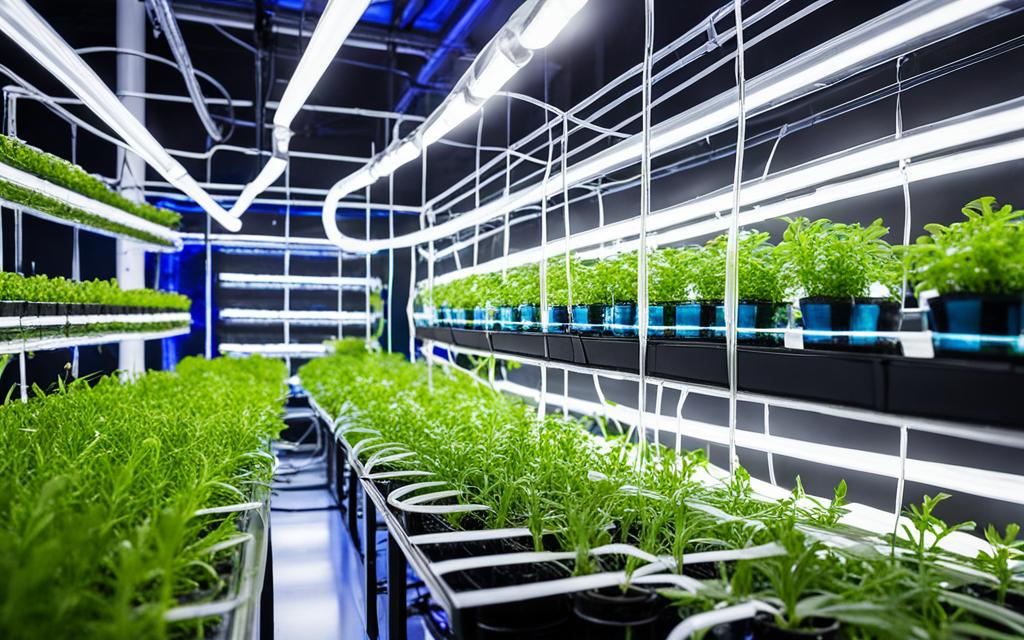
By carefully controlling the light, temperature, and humidity, growers can help hydroponic tarragon reach its full potential. This leads to strong growth and keeps the herb’s unique flavor.
Pruning and Harvesting Hydroponic Tarragon
Proper pruning and harvesting are key for keeping your hydroponic tarragon plants healthy and productive. Tarragon can grow quite tall, so regular pruning helps keep it under control and encourages new growth.
When pruning hydroponic tarragon, cut the stems at the right length without harming the leaves. Make sure to leave at least one-third of the foliage to support growth. Use clean, sharp scissors or pruning shears to snip the stems just above healthy leaves.
Harvesting hydroponic tarragon requires care. Take leaves as needed, but don’t take too much. Cutting stems at the right length and leaving foliage ensures a steady harvest throughout the season.
Tarragon is a versatile herb that can be used fresh or preserved. To store it, wrap stems in a damp paper towel and put them in a plastic bag in the fridge. This keeps the herb fresh for up to two weeks.
“Proper pruning and harvesting techniques are the key to maintaining a healthy and productive hydroponic tarragon crop.”
By following these best practices for pruning and harvesting hydroponic tarragon, you’ll have a steady supply of this tasty herb. Enjoy the fruits of your hydroponic gardening efforts in your cooking.
Pest and Disease Management
Keeping hydroponic tarragon healthy and productive means watching closely and using strategies to fight pests and diseases. Hydroponic tarragon can get pests and diseases if its growing space isn’t kept clean.
Common Pests Affecting Hydroponic Tarragon
Spider mites are a big problem for hydroponic tarragon. These tiny bugs can spread fast, harming leaves and slowing plant growth. To fight spider mites, growers can use special oils or sprays.
Identifying and Treating Diseases
Tarragon can also get diseases like tarragon hydroponic rust and tarragon hydroponic mildew. Rust shows up as orange or reddish spots on leaves. Mildew looks like a white, powdery coating on the leaves.
To fight these diseases, it’s important to keep things clean and air moving. Check plants often, pull out any sick or damaged leaves, and make sure air flows well. If needed, use fungicides to stop these hydroponic tarragon diseases from spreading.
| Pest/Disease | Symptoms | Management Strategies |
|---|---|---|
| Spider Mites | – Tiny, web-like structures on leaves – Discolored, stippled, or yellowing leaves | – Insecticidal oils or sprays – Maintain proper humidity levels |
| Tarragon Hydroponic Rust | – Orange or reddish-brown spots on leaves | – Improve air circulation – Remove infected leaves – Apply targeted fungicides |
| Tarragon Hydroponic Mildew | – White, powdery coating on leaves | – Increase air movement – Remove affected foliage – Use fungicides as needed |
Using a strong hydroponic tarragon pest and disease management plan helps growers keep their crops healthy. Regular checks, quick action, and a mix of methods are key to fighting pests and diseases.
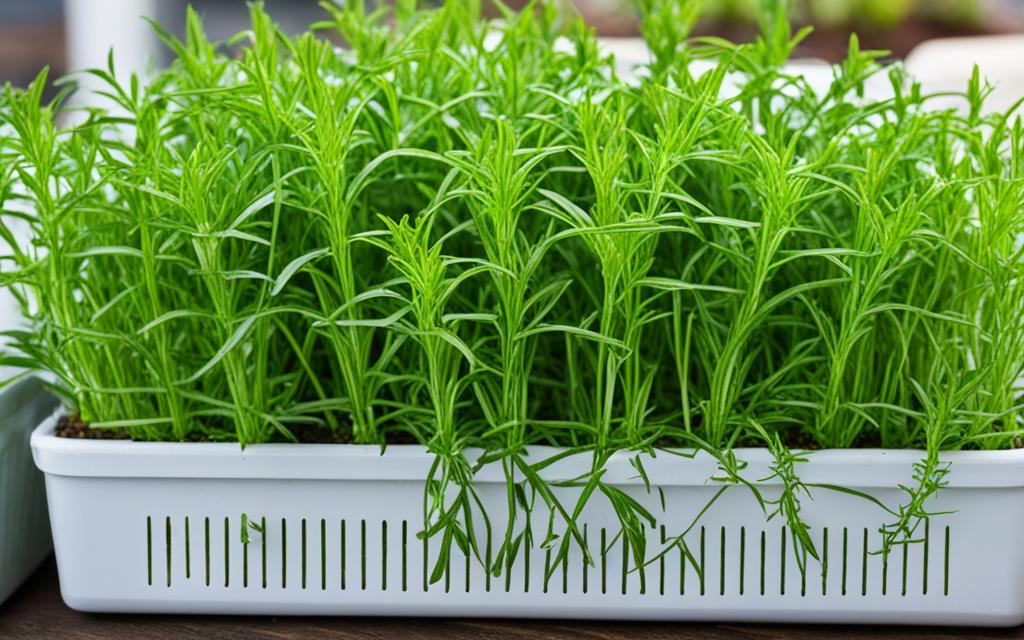
Growing Tarragon Hydroponically in Different Systems
Tarragon is a fragrant and flavorful herb that does well in many hydroponic systems. Two top methods for growing hydroponic tarragon are the Deep Water Culture (DWC) and the Nutrient Film Technique (NFT) systems.
Deep Water Culture Systems
The deep water culture (DWC) system is great for growing hydroponic tarragon. It keeps the plant’s roots in a nutrient-rich solution. This means the roots always get the nutrients they need for growth. DWC is simple and easy to maintain, making it popular among both new and experienced growers.
Nutrient Film Technique (NFT) Systems
The nutrient film technique (NFT) system is another good choice for hydroponic tarragon. It uses a thin film of nutrient solution over the roots. This method is great for large-scale hydroponic tarragon farming because it can be easily expanded.
When picking the best hydroponic system for tarragon, think about the space you have, how much you want to produce, and your experience level. Both DWC and NFT systems have their own benefits and can be the best choice for growing this tasty herb.
No matter the system you choose, it’s important to keep the environment right, the nutrients balanced, and the water clean. By knowing what hydroponic tarragon needs and picking the right system, growers can have a successful crop all year.
Maximizing Yield and Quality
To get the best yield and quality from hydroponic tarragon, use smart pruning and training. Also, keep the environment just right. These steps help growers get the most out of their hydroponic tarragon crop. They ensure the herbs are tasty and of high quality.
Pruning and Training Techniques
Pruning is key for optimizing hydroponic tarragon. Cut off flower buds as they form and take leaves often. This makes the plant focus on growing tasty leaves instead of making seeds.
Training methods also boost hydroponic tarragon yield and quality. Techniques like pinching, topping, and trellising shape the plant. This leads to more leaves you can pick.
Optimizing Environmental Conditions
For high-quality hydroponic tarragon, the environment matters a lot. Control lighting, temperature, humidity, and nutrients well. This helps the plant grow strong and produce tasty leaves.
- Lighting: Hydroponic tarragon loves bright places. Use natural and LED grow lights for enough light for photosynthesis and growth.
- Temperature: Keep the temperature between 65°F and 75°F (18°C to 24°C). A steady temperature is key for quality and yield.
- Humidity: Keep humidity at 40% to 60%. This stops diseases and helps the plant absorb water and breathe well.
- Nutrient Delivery: Check and adjust the nutrient solution’s pH, conductivity, and ingredients. This makes sure hydroponic tarragon gets all it needs for great growth and quality.
By using these pruning, training, and environmental tips, growers can make the most of their hydroponic tarragon. This leads to a big harvest of tasty, high-quality herbs.
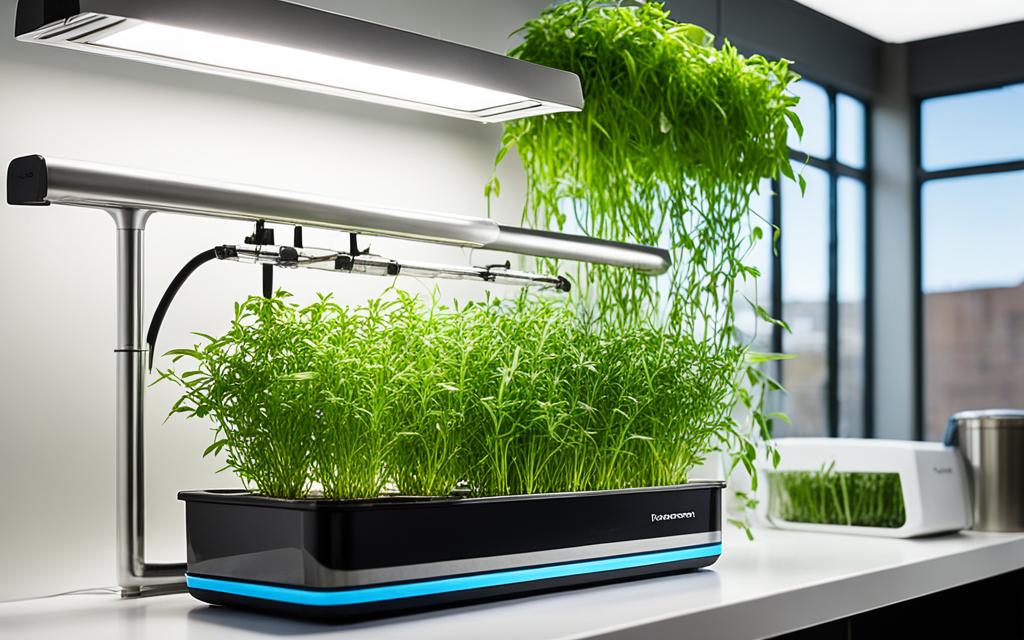
Hydroponic Tarragon for Commercial Production
Commercial hydroponic tarragon farming is a great way to produce tarragon all year round. It ensures a steady supply of fresh, tasty tarragon for chefs and food lovers. This method controls the growing conditions, making sure the tarragon is always of high quality.
Hydroponic tarragon farming has many benefits over traditional soil farming. It grows faster, reaching harvest size in just five weeks, unlike seven weeks for soil-grown plants. The first harvest can bring in up to 5 pounds per table or 1 pound per 8 square feet. After a 3-week break, you can harvest again, and over six months, you can get up to 8 pounds per table.
| Metric | Hydroponic Tarragon | Potted Tarragon |
|---|---|---|
| Growth Rate | 1/3 faster | Slower |
| Time to Harvest | 5 weeks | 7 weeks |
| Initial Harvest Yield | 5 lbs per table or 1 lb per 8 sq ft | 1 lb per 55 plants |
| Harvest Recovery Period | 3 weeks | 5 weeks |
| 6-Month Harvest Yield | 8 lbs per table per harvest | 1 lb per 40 plants |
Hydroponic systems let farmers grow tarragon consistently and in large quantities, even in places where it’s hard to grow it in soil. This makes hydroponic tarragon a great choice for commercial growers and chefs. They can always have a steady supply of fresh, tasty herbs.
Starting a hydroponic system costs more than traditional farming. But, it offers more yield, cuts down on labor costs, and lets you grow tarragon all year. This makes it a good choice for large-scale farming. As more people want fresh, local herbs, growing hydroponic tarragon can be a smart business move.
Culinary Uses of Hydroponic Tarragon
Hydroponic tarragon has a fresh, subtle flavor that makes it great for many dishes. It goes well with fish, chicken, eggs, and vegetables. This makes it a key ingredient in French cooking.
Cooking with Fresh Hydroponic Tarragon
Fresh hydroponic tarragon adds a special touch to many dishes. It’s a must-have in French sauces like béarnaise, adding a unique flavor. You can also use it to season meats, sautéed veggies, and scrambled eggs.
Preserving and Storing Hydroponic Tarragon
Even though fresh tarragon is best, you can also preserve it. Freezing the leaves keeps its flavor and aroma. Or, you can make tarragon-infused vinegar for salad dressings and marinades.
To keep fresh hydroponic tarragon, treat it like fresh flowers. Wrap the stems in a damp paper towel and put them in a plastic bag or container. Keep it in the fridge for up to a week to keep its color and flavor.
| Culinary Use | Flavor Profile | Preparation Method |
|---|---|---|
| Béarnaise Sauce | Fragrant, Licorice-like | Fresh Tarragon Leaves |
| Roasted Meats | Earthy, Herbal | Fresh or Dried Tarragon |
| Sautéed Vegetables | Aromatic, Subtle | Fresh Tarragon Leaves |
| Scrambled Eggs | Delicate, Licorice-like | Fresh Tarragon Leaves |
| Tarragon Vinegar | Pungent, Herbal | Infused Vinegar |
Hydroponic tarragon can make any dish special, from classic French meals to everyday food. Whether fresh or preserved, it adds a unique flavor to many dishes. This makes cooking with hydroponic tarragon and using hydroponic tarragon a memorable experience.
Troubleshooting Common Issues
Even the best hydroponic tarragon growers sometimes face problems like nutrient shortages, pests, or diseases. Keeping an eye on your plants and fixing problems quickly helps keep them healthy and productive. Issues you might see include yellow leaves, slow growth, or pests like spider mites. Knowing how to spot and fix these problems is key to your hydroponic tarragon’s success.
Identifying and Resolving Nutrient Deficiencies
Getting the right nutrients is vital for healthy hydroponic tarragon. Signs of nutrient shortages include:
- Yellowing or discolored leaves
- Stunted growth
- Weak or brittle stems
To fix nutrient issues, test your nutrient solution and adjust it as needed. Use a hydroponic nutrient guide or get advice from a local expert to make sure your tarragon gets the right nutrients.
Controlling Pests and Diseases
Hydroponic setups can face pest and disease problems. Common issues are:
- Spider mites
- Aphids
- Powdery mildew
- Root rot
Check your plants often and deal with pests or diseases right away. Use methods like introducing helpful insects or organic pesticides to keep your hydroponic tarragon healthy.
Optimizing Environmental Conditions
Right environmental conditions are crucial for growing hydroponic tarragon. Make sure your plants get enough light, the right temperature and humidity, and good air flow. Adjust these factors as needed to prevent problems like wilting or disease.
By being alert, solving problems, and making changes on time, you can beat the usual challenges of hydroponic tarragon growing. Remember, hydroponic tarragon troubleshoot and troubleshooting hydroponic tarragon are key to a successful hydroponic tarragon setup.
“Proper care and attention are the keys to successful hydroponic tarragon cultivation. By addressing issues proactively, you can ensure a healthy, productive crop.”
Conclusion
Growing hydroponic tarragon brings many benefits. You get fresh herbs all year, more plants, and consistent quality. Choosing the right tarragon type and hydroponic system is key. With the right care, hydroponic tarragon can be a great addition to your kitchen.
This hydroponic tarragon guide covered everything from starting seeds to managing pests. By using these hydroponic tarragon tips, you can keep your indoor garden healthy and full of tarragon. This means you can enjoy fresh, tasty tarragon all year.
These methods work for both new and experienced hydroponic growers. They help you make the most of hydroponic tarragon. With this method, you can have the taste of homegrown tarragon easily.
